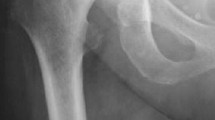Summary
From 1986 to 1996, we implanted a total of 92 hip arthroplasties (86 cementless, 4 hybrid and 2 cemented) in 65 patients with rheumatoid arthritis. Of the 89 uncemented cups, 59 were threaded cups (Hofer-Imhof n = 45, Zweymüller n = 7, Mecring n = 5, PM n = 2) and 30 were hemispherical cups of the Harris Galante type I and II. 87 stems were implanted without cement (Zweymüller SL n = 58, Uni n = 16, Schenker n = 9, Zweymüller I n = 4) and 5 with cement. One patient died postoperatively and three (4 implants) within the first year. To date, one cup of each threaded type had to be revised because of loosening (revision rate approx. 6.8 %); Up to now, three of 87 (approx. 3.4 %) stem revisions (1 × Zweymüller I, 1 × Schenker, 1 × Zweymüller SL) have been undertaken. Ten patients with twelve hip arthroplasties did not return for follow-up; some of them had a poor general health status. The clinical and radiological results of the arthroplasties of 52 patients showed a Harris Hip Score averaging 72 after an average of 54 months (min. 12-max. 132). Ten patients had minor complaints in the hip region. 79 % of the uncemented implants (70 out of 89 cups, 69 out of 87 stems) were assessed radiologically. Two threaded cups showed slight migration after cancellous bone grafting in the presence of acetabular protrusion that was present in a total of 13 hip joints. This subsided markedly after filling with cancellous bone and recentering of the hip joint. Homogeneous incorporation of the bone grafting und thus remodelling of the medial wall was achieved, with the bone graft exhibiting marked reduction. At final follow-up, approx. 75 % of the cementless cups had complete bone ingrowth without any evidence of radiolucency (type I), approx. 19 % had near-complete bone ingrowth with minimal radiolucencies in one zone or in a maximum of 50 % of the bone contact area (type II) and approx. 6 % had radiolucencies in more than 50 % of the bone contact area (type III). The radiographic evaluation of the most frequently used stem (Zweymüller SL) showed approx. 47 % with only slight remodelling of the calcar (type I), approx. 33 % with moderate loss of femoral density (type II) and approx. 20 % with severe bone loss and thinning of cortical bone (type III).
Zusammenfassung
Von 1986–1996 wurden bei 65 Patienten mit rheumatoider Arthritis (RA) 92 Hüftendoprothesen (86 zementfrei, 4 hybrid, 2 zementiert) implantiert. Von den 89 zementfreien Pfannen waren 59 Schraubpfannen (Hofer-Imhof: n = 45; Zweymüller: n = 7; Mecring: n = 5; PM: n = 2) und 30 sphärische Pfannen vom Typ Harris-Galante; 87 Schäfte wurden zementfrei (Zweymüller-SL: n = 58; Uni: n = 16; Schenker: n = 9; Zweymüller I: n = 4) und 5 zementiert eingesetzt. Postoperativ starb eine Patientin, 3 Patienten (4 Implantate) innerhalb des 1. postoperativen Jahres. Von jedem Schraubpfannentyp mußte bisher eine Pfanne gewechselt werden (4 von 59; ca. 6,8 %). Bei 3 von 87 Schäften (ca. 3,4 %; einmal Zweymüller I, einmal Schenker, einmal Zweymüller SL) war ebenfalls ein Wechsel erforderlich, so daß bei insgesamt 7 von 86 (ca. 8 %) zementfreien Prothesen ein Wechsel erfolgte. 10 Patienten mit 12 Hüftendoprothesen sind zur Nachuntersuchung z. T. wegen ihres reduzierten Allgemeinzustands nicht erschienen; 4 Patienten (5 Implantate) sind verstorben. Die klinischen und radiologischen Ergebnisse der Hüftendoprothesen von 52 Patienten mit 70 zementfreien Pfannen und 68 zementfreien bzw. 2 zementierten Schäften zeigen nach durchschnittlich 4,5 (1–11) Jahren einen Harris-Hip-Score von durchschnittlich 72 (25–96); 10 Patienten haben geringe Beschwerden im Hüftbereich; ca. 79 % der zementfreien Implantate (70 von 89 Pfannen, 69 von 87 Schäften) wurden radiologisch ausgewertet; 2 Schraubpfannen zeigen eine geringe Positionsänderung nach Spongiosaplastik bei Pfannenprotrusion, die insgesamt bei 13 Hüftgelenken präoperativ vorlag. Diese bildete sich nach Auffüllung mit autologen Spongiosachips und Rezentrierung des Hüftgelenks deutlich zurück. Es kam zu einem Neuaufbau des Pfannenbodens mit homogenen Durchbau der Spongiosaplastik, wobei diese eine deutliche Verschmälerung zeigte. Die zementfreien Pfannen haben in ca. 75 % einen Typ I mit vollständiger Osseointegration, in ca. 19 % einen Typ II mit Saum an einzelnen Gewindegängen, in einer Zone oder maximal 50 % der Bedeckungsfläche und in ca. 6 % einen Typ III mit Saum in mehr als 50 % der knöchernen Bedeckungsfläche. Die Beurteilung hinsichtlich des Knochenumbaus am Schaft ergab für den am häufigsten verwendeten Schaft (Zweymüller SL) in ca. 47 % einen Typ I mit nur geringem Knochenumbau am Calcar, in ca. 33 % einen Typ II mit deutlicher Spongiosierung im gesamten Schaftbereich, jedoch bei erhaltener Kompaktabreite, und in ca. 20 % einen Typ III mit deutlicher Spongiosierung und Verschmälerung der Kompakta.
Similar content being viewed by others
Author information
Authors and Affiliations
Rights and permissions
About this article
Cite this article
Effenberger, H., Lassmann, S., Hilzensauer, G. et al. Cementless hip replacement in patients with rheumatoid arthritis. Orthopäde 27, 354–365 (1998). https://doi.org/10.1007/PL00003507
Published:
Issue Date:
DOI: https://doi.org/10.1007/PL00003507




